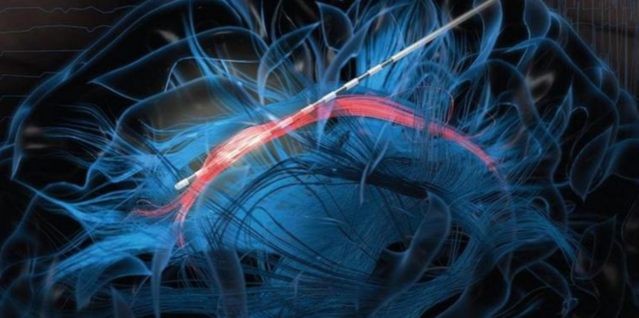Anxiety
Have Neuroscientists Found a “Happy Place” in the Brain?
Electrical stimulation of the cingulum bundle can trigger immediate laughter.
Posted February 18, 2019

Sometimes during brain surgery, it’s necessary for patients to stay awake so doctors can talk to them and continually assess language skills and other possible impairments that might occur during a neurosurgical procedure. Of course, being fully conscious for an "awake" brain procedure—while a surgeon is poking around inside your skull—is probably one of the most nerve-racking and anxiety-inducing experiences any of us can imagine.
Therefore, researchers at the Emory School of Medicine are investigating the potential of electrical stimulation to a brain region called the "cingulum bundle" to help patients lower anxiety during a craniotomy, which is often an "awake" brain procedure. Craniotomies involve a neurosurgeon removing a section of bone from the skull to expose brain tissue for a procedure.
As you can see in the image at the top of this page, the cingulum bundle (in pink) gets its Latin name meaning “girdle or belt” because it hugs the underbelly of the cerebral cortex and curves above the midbrain. This bundled pathway of white matter tracts acts like a communication relay-station that helps multiple brain regions stay interconnected.
In a series of novel experiments, the Emory neuroscientists discovered that electrically stimulating a target area of this newly-discovered "happy place" in the brain reduced anxiety, improved mood, and even made people laugh out loud during an awake brain procedure.
Their paper, “Cingulum Stimulation Enhances Positive Affect and Anxiolysis to Facilitate Awake Craniotomy,” was recently published in the Journal of Clinical Investigation. Kelly Bijanki, assistant professor of neurosurgery at Emory, was the lead author of this study.
Interestingly, Bijanki and colleagues found that stimulating the cingulum bundle triggered immediate laughter followed by a sense of calmness and happiness in three craniotomy patients.
Please note: The sample size used for this exploratory study is minuscule; these preliminary findings are based solely on tests involving three patients with epilepsy who were undergoing seizure monitoring during awake craniotomies. Additionally, this study is not part of a formal clinical trial. Much more research is needed before drawing any conclusions on the universal ability of cingulum stimulation to reduce anxiety or trigger spontaneous laughter.
That said, the authors explain why these new findings offer promise, "Low-amplitude stimulation [of the cingulum bundle] induced acute outward signs of mirth, subjective reports of happiness and relaxation, and persistent objective behavioral features of positive affect."
Bijanki described how cingulum stimulation worked on one of her three patients in a statement:
"Even well-prepared patients may panic during awake surgery, which can be dangerous. This particular patient was especially prone to it because of moderate baseline anxiety. And upon waking from global anesthesia, she did indeed begin to panic. When we turned on her cingulum stimulation, she immediately reported feeling happy and relaxed, told jokes about her family, and was able to tolerate the awake procedure successfully."
According to the latest research on cingulum stimulation possibly tapping into a “happy place” in the brain, the specific area directly linked to mirth and laughter is on the top and near the front of the cingulum—where the stripped straw-like probe is being inserted in the illustration at the top of this page.
“The [cingulum] bundle is a logical target because of its many connections among brain regions coordinating complex emotional responses,” senior author Jon Willie from the Emory University Department of Neurosurgery said in a statement.
Kelly Alexander Mills from the Department of Neurology at Johns Hopkins University School of Medicine (who was not involved in this research) wrote an accompanying commentary about these findings. In a commentary piece, “Probing the Happy Place," he wrote:
"A variety of neurological procedures, including deep brain stimulation and craniotomies that require tissue removal near elegant cortices, require patients to remain awake and responsive in order to monitor function. Such procedures can produce anxiety and are poorly tolerated in some subjects.
In this issue of the Journal of Clinical Investigation, Bijanki and colleagues demonstrate that electrical stimulation of the left dorsal anterior cingulum bundle promoted a positive (mirthful) effect and reduced anxiety, without sedation, in three patients with epilepsy undergoing intracranial electrode monitoring. The results of this study highlight the need for further evaluation of anterior cingulum stimulation to reduce anxiety during awake surgery and as a possible approach for treating anxiety disorders.”
Although future applications of cingulum stimulation offer exciting potential, the authors make the limitations of this small study very clear in their one-sentence conclusion: “The current study demonstrates a robust anxiolytic response to cingulum bundle stimulation in 3 patients with epilepsy.”
Nevertheless, the Emory neurosurgeons are cautiously optimistic that electrical stimulation of the cingulum bundle could turn out to be a “potentially transformative” way to keep patients calm and anxiety-free during awake surgery.
Hopefully, these preliminary findings (Bijanki et al., 2019) on the possible benefits of cingulum stimulation will lead to funding for a larger clinical trial that will reproduce and corroborate the initial results based on just three patients.
Beyond performing craniotomies while a patient is awake, gaining a better understanding of the psychological ripple effects of electrical stimulation to the cingulum bundle could lead to previously unexplored ways to help those with anxiety disorders, treatment-resistant depression, or chronic pain.
References
Kelly R. Bijanki, Joseph R. Manns, Cory S. Inman, Ki Sueng Choi, Sahar Harati, Nigel P. Pedersen, Daniel L. Drane, Allison C. Waters, Rebecca E. Fasano, Helen S. Mayberg, Jon T. Willie. "Cingulum Stimulation Enhances Positive Affect and Anxiolysis to Facilitate Awake Craniotomy." Journal of Clinical Investigation (In-Press Preview Published: December 27, 2019/Electronic Publication (Version 2) Published: February 11, 2019) DOI: 10.1172/JCI120110
Commentary by Kelly A. Mills. "Probing the Happy Place." Journal of Clinical Investigation (First published: February 11, 2019) DOI: 10.1172/JCI126683




